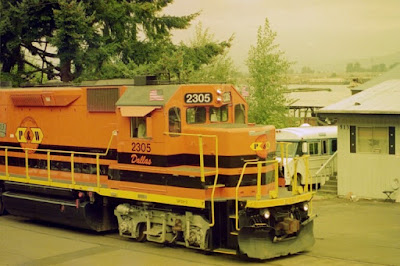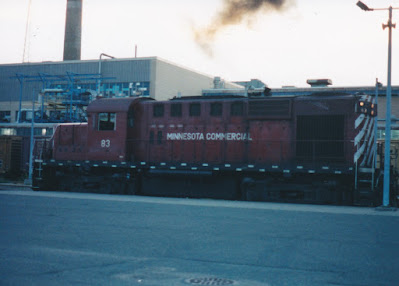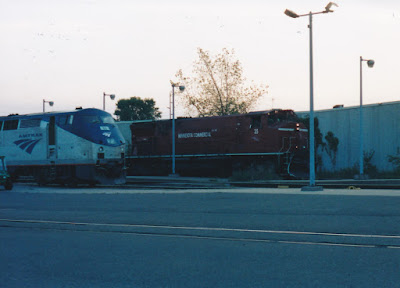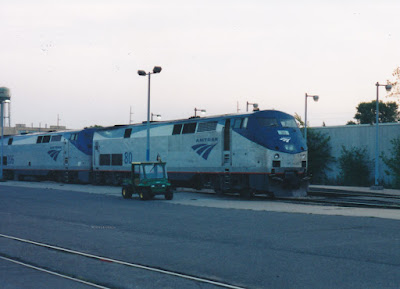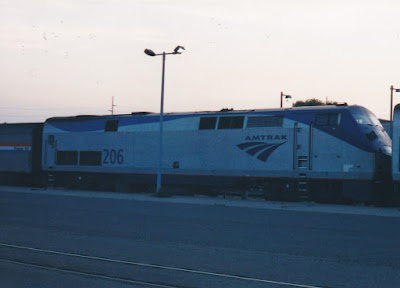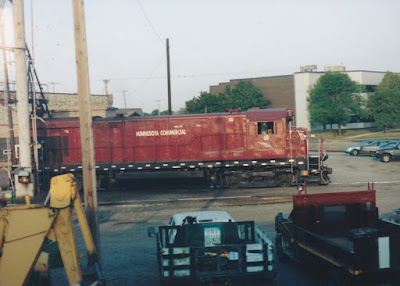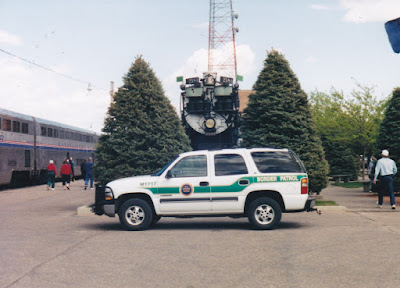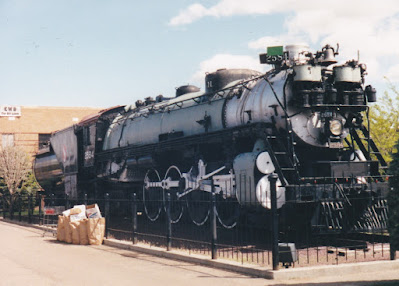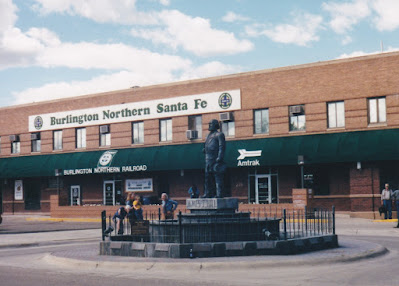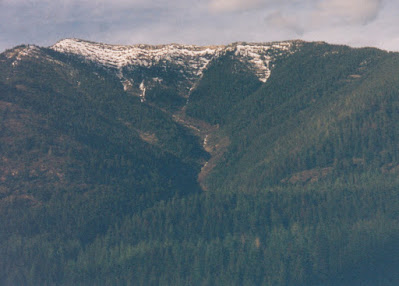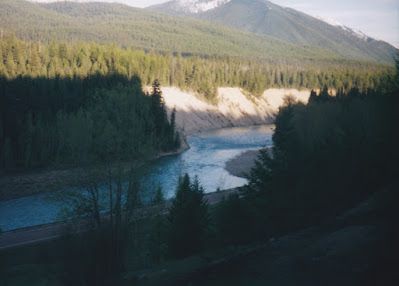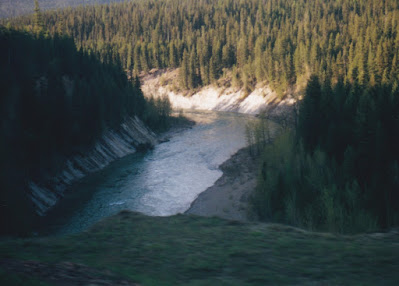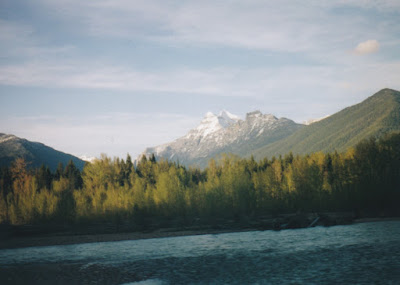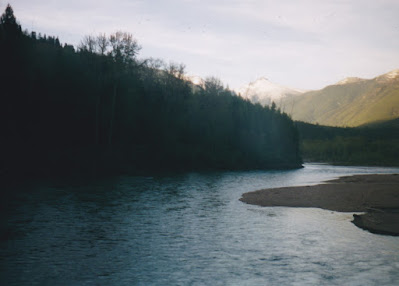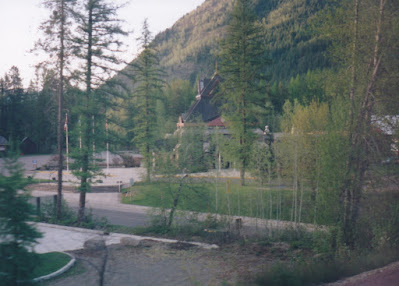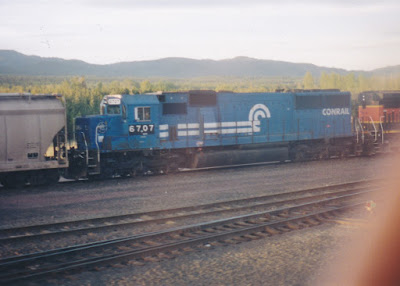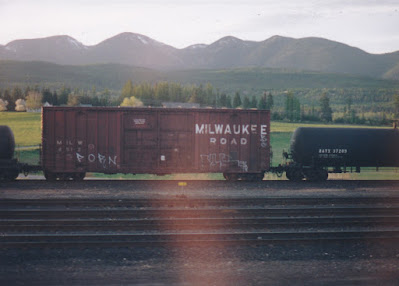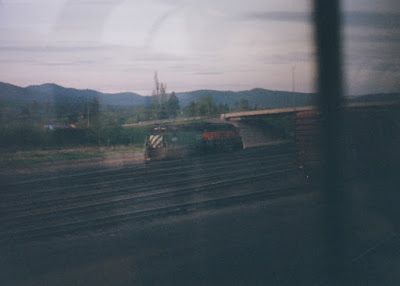Portland & Western GP39-2 #2305 Dallas is a 2,300-horsepower GP39-2 that was built by the Electro-Motive Division of General Motors in August 1974 as Atchison, Topeka & Santa Fe #3604. It was retired in December 1992 and was sold to the Willamette & Pacific Railroad in June 1993 and later transferred to the Portland & Western.
Sunday, March 27, 2022
Portland & Western Special Train at Rainier, Oregon, in Fall 2003
Lewis & Clark Explorer at Laurel Beach in Lindbergh, Oregon, in Fall 2003
To commemorate the bicentennial of the Lewis and Clark Expedition, the Oregon Department of Transportation operated an excursion train along the south bank of the lower Columbia River from Linnton, near Portland, to Astoria, near the site of Fort Clatsop, where the Lewis and Clark Expedition wintered over in 1805-06. The train ran for the summers of 2003 to 2005, making one round trip on Fridays, Saturdays, Sundays and Mondays.

Photo by Cliff West
BNSF SD40-2 #6731 in Wishram, Washington, in Fall 2003
BNSF #6731 is a 3,000-horsepower SD40-2 that was built by the Electro-Motive Division of General Motors in September 1979 as Atchison, Topeka & Santa Fe #5072. Following the merger of the Burlington Northern and the Atchison, Topeka & Santa Fe on September 22, 1995, this locomotive became Burlington Northern Santa Fe #6731 on March 12, 1999. My dad, Cliff West, photographed it at Wishram, Washington, in the fall of 2003.
Lewis & Clark Explorer Train in the Fall of 2003
To commemorate the bicentennial of the Lewis and Clark Expedition, the Oregon Department of Transportation operated an excursion train along the south bank of the lower Columbia River from Linnton, near Portland, to Astoria, near the site of Fort Clatsop, where the Lewis and Clark Expedition wintered over in 1805-06.
These first two pictures show the train passing the farm between Deer Island and Tide Creek.
These next two pictures show the train passing through Goble.
Note that there are only two cars on the train. The train normally ran with three cars, but sometimes only needed two for the number of tickets sold.
Lewis & Clark Explorer #10 & #11 are RDC-1s that were built by Budd in August 1956 for the Pacific Great Eastern as #BC-10 & #BC-11. The Pacific Great Eastern became the British Columbia Railway on April 1, 1972, when it was taken over by British Columbia’s provincial government. The railroad began going by the name BC Rail on June 19, 1984. The cars were purchased by the state of Oregon’s Department of Transportation from the British Columbia Railway, which had ended its passenger service in 2002.
The train ran for the summers of 2003 to 2005, making one round trip on Fridays, Saturdays, Sundays and Mondays.
Trains in the Twin Cities in September 2003
I took these pictures in St. Paul, Minnesota, on the morning of September 6, 2003, while traveling on Amtrak’s eastbound Empire Builder. St. Paul was a highlight for me, as the Minnesota Commercial and Soo Line equipment visible from the train seemed exotic to an Oregonian like me.
Switching at Amtrak’s Midway Station in St. Paul during the Empire Builder’s service stop, Minnesota Commercial #83 is an 1,800-horsepower RS18u that was built by Montreal Locomotive Works in April 1958 as Canadian Pacific RS18 #8785. In 1987 it was rebuilt as RS18u #1837. On July 16, 1998, it was sold to Minnesota Commercial as #83.
Bringing up the rear of the Empire Builder, Amtrak Superliner I Sleeping Car #32009 was completed by Pullman-Standard on May 22, 1981. It was the last Superliner I and the last passenger car built by Pullman-Standard. As a result, it was named George M. Pullman in honor of Pullman-Standard’s founder in a ceremony at its completion, before being delivered to Amtrak in July 1981. It is one of only two Superliner I cars to have a name applied.
Parked at Midway Station, Amtrak (AMTZ) #462113 is a RoadRailer trailer built by the Wabash National Corporation. It is the 10,000th RoadRailer trailer built. RoadRailer trailers could be operated on rails without the use of flatcars, supported by a specialized railcar truck between trailers. Amtrak began purchasing RoadRailer trailers in May 1998 to carry mail and express shipments.
After being retired on February 5, 1998, it was sold to National Railway Equipment in Illinois in June 1998 and subsequently resold to Minnesota Commercial as #35.
Leading the Empire Builder, Amtrak P42DC #80 is a 4,250-horsepower P42DC that was built by General Electric in April 1997.
The Empire Builder's second unit, Amtrak P42DC #206 is a 4,250-horsepower P42DC that was built by General Electric in October 2001.
Also part of the Empire Builder's consist, Amtrak Superliner II Sightseer Lounge #33034 was built by Bombardier in 1993. It was involved in an accident in Nodaway, Iowa, in March 2001 and returned to service on August 27, 2003, as one of the first Superliner cars to wear Amtrak’s new paint scheme, with the new logo and red sill stripe.
Amtrak’s Empire Builder passes Minnesota Commercial’s nearby roundhouse in Minneapolis. Minnesota Commercial #68 is a 2,250-horsepower B23-7 that was built by General Electric in March 1979 as Conrail #1972. It was retired in 1999 and sold to the Quincy Bay Terminal, where it became #22. It was resold to the Minnesota Commercial Railway, where it became #68.
Minnesota Commercial #316 is a 2,400-horsepower RS-27 that was built by Alco Products in March 1962 as Chicago & North Western Railway #903. Only 27 examples of the RS-27 were produced; the Chicago & North Western owned four, which were returned to Alco in 1966 in trade for C-424s. Alco leased them to various railroads in 1967 and 1968. This unit was sold to the Green Bay & Western in 1968 and became #316. It was later joined by two of the others. On August 27, 1993, the Green Bay & Western was merged with the Fox River Valley Railroad to form the Fox River & Western, a subsidiary of the Wisconsin Central, and this locomotive was sold to the Minnesota Commercial Railroad.
Conrail #1998 is a 2,250-horsepower B23-7 that was built by General Electric in July 1979. It was retired by Conrail in 1999 and was sold to the Minnesota Commercial Railroad, but has yet to be placed in service and still wears full Conrail paint and lettering.
Conrail #2002 is another 2,250-horsepower B23-7 that was built by General Electric in August 1979. It was retired by Conrail in 1999 and was sold to the Minnesota Commercial Railroad, but has yet to be placed in service and still wears full Conrail paint and lettering.
Minnesota Commercial #80 is a 1,000-horsepower RS23 that was built by Montreal Locomotive Works in September 1959 as Canadian Pacific #8031. It was retired in March 1999 and ended up with the Minnesota Commercial as #80.

Northern States Power Company (NSPX) #501 is a 1,200-horsepower SW1200RS that was built by General Motors Diesel Limited in February 1956 as Canadian National #1576 and was renumbered by the end of the year to #1205. It was retired in 1991. It was acquired by the Northern States Power Company and was used at the High Bridge Generating Plant in St. Paul, Minnesota, where is it pictured here. This coal-fired power plant at 501 Shepard Road was completed in 1941.
Canadian Pacific #4611 is a 3,000-horsepower GP40 that was built by the Electro-Motive Division of General Motors in March 1966 as Milwaukee Road #180. In 1968 it was renumbered to Milwaukee Road #2025. The Soo Line purchased the bankrupt Milwaukee Road in February 1985, and this locomotive became Soo Line #2025. The Soo Line was consolidated into owner CP Rail in 1991, and in October 1997 it was rebuilt by Canadian Pacific and became Canadian Pacific #4611.
Trains in Minot and Williston in September 2003
I took these pictures while riding Amtrak’s eastbound Empire Builder on September 5, 2003. The Empire Builder’s Heritage Baggage Car for this trip was Amtrak #1851, which I photographed during the train’s service stop in Havre, Montana. This car was built by the St. Louis Car Company in 1953 as U.S. Army (USAX) Hospital Ward Car #89566. It became Amtrak “Le Pub” Bar-Lounge Car #3405 in March 1974 and was used in service on the Montrealer between Washington DC and Montreal, and notably featured an electric piano. In June 1982 it was rebuilt as a baggage car with head-end power and became Amtrak 1178. In 1998 it was refurbished for service on the Adirondack between New York City and Montreal, becoming Amtrak #1851 and receiving large advertising murals for the Adirondack. It was one of several Amtrak baggage cars to be decorated for trains in the Northeast. By this time the car had been transferred into general service, but retained its special paint scheme.
I photographed
Great Northern O-1 Class 2-8-2 #3059 from the train during the eastbound Empire Builder’s station stop at Williston,
North Dakota. The Great Northern had a total of 145 O-1 Class 2-8-2
Mikados built by the Baldwin Locomotive Works in four groups between August
1911 and February 1919, and the last of them were retired in April
1958. Built in February 1913, #3059 was one of the last 15 in operation
when it was retired in December 1957, and is the only survivor. It was donated
to the City of Williston and placed on display in Railroad Park on August 2,
1958.
Great Northern P-2 4-8-2 #2507 in Wishram, Washington on September 4, 2003
While riding the Portland section of Amtrak’s eastbound Empire Builder through Wishram, Washington, on September 4, 2003, I took this picture of former Great Northern Railway steam locomotive #2507 in a small park near the depot. This locomotive was one of 28 Class P-2 4-8-2 Mountain-type locomotives delivered to Great Northern by the Baldwin Locomotive Works. These locomotives were originally assigned to passenger service and were the initial power for the Empire Builder when it was inaugurated in June, 1929, but were replaced in Empire Builder service in 1930 by 14 new Baldwin Class S-2 4-8-4 Northern-type locomotives that pulled the Empire Builder until it was streamlined and dieselized in 1947. The Class P-2 Mountains were then assigned to freight service until their retirement in 1955. After its retirement, #2507 was put into storage in Minnesota instead of being immediately scrapped. Meanwhile, the Spokane, Portland & Seattle promised a steam locomotive to Klickitat County for display at Maryhill, only to end up having no steam locomotives left; #700 had been given to the city of Portland, #539 to the city of Vancouver, and the rest sold for scrap. To save face, the SP&S purchased #2507 from parent Great Northern, repainted it with SP&S lettering, and donated it to Klickitat County in 1962. For 30 years, #2507 sat on display in Maryhill in SP&S paint. An attempted restoration saw #2507 painted back to GN in 1992, and in 1994 it was moved from Maryhill to Pasco to be restored to operation. No restoration ever occurred, and eventually Klickitat County decided to put the locomotive back on permanent display. Track realignments had made a return to Maryhill impractical, so a new site in Wishram was chosen. The locomotive was given a complete cosmetic restoration and a structure was built to protect the locomotive from the elements. BNSF donated the locomotive's move from Pasco to Wishram.
Lewis & Clark Explorer in Rainier, Oregon in the Summer of 2003
The train ran for the summers of 2003 to 2005, making one round trip on Fridays, Saturdays, Sundays and Mondays. This was my first opportunity to photograph the train as it made its return trip through Rainier, Oregon, in the summer of 2003 as the evening light faded.
Saturday, March 26, 2022
Riding Amtrak's Westbound Empire Builder in May 2003
I took these pictures while riding Amtrak’s westbound Empire Builder through Montana on May 24, 2003. The pictures begin with the train’s arrival in Havre, Montana.
As the train passed the Havre engine terminal, a variety of motive power could be seen. Norfolk Southern #9086 is a 4,000-horsepower Dash 9-40CW that was built by General Electric in March 1997. Burlington Northern Santa Fe #6730 is a 3,000-horsepower SD40-2 that was built by the Electro-Motive Division of General Motors in September 1979 as Atchison, Topeka & Santa Fe #5071. Following the merger of the Burlington Northern and the Atchison, Topeka & Santa Fe on September 22, 1995, this locomotive became Burlington Northern Santa Fe #6730 on January 20, 1998. Burlington Northern Santa Fe #7909 is a 3,000-horsepower SD40-2 that was built by the Electro-Motive Division of General Motors in June 1979 as Colorado & Southern #7909. Colorado & Southern was a subsidiary of Burlington Northern, and its locomotives were painted in Burlington Northern colors. The Colorado & Southern was formally merged into the Burlington Northern on December 31, 1981, and this locomotive became Burlington Northern #7909. Following the merger of the Burlington Northern and the Atchison, Topeka & Santa Fe on September 22, 1995, this locomotive became Burlington Northern Santa Fe #7909.
Near the Havre shops, BNSF #507 is a 4,000-horsepower Dash 8-40BW that was built by General Electric in October 1990 as Atchison, Topeka & Santa Fe #507. Following the merger of the Burlington Northern and the Atchison, Topeka & Santa Fe on September 22, 1995, this locomotive became Burlington Northern Santa Fe #507 on May 8, 2001.
Havre is only 40 miles from the Canadian border, and the Border Patrol meets Amtrak's Empire Builder in Havre, to catch illegal aliens attempting to board the train. As a result, there are often Border Patrol vehicles parked at the station.
Leading the westbound Empire Builder, Amtrak #152 is a 4,250-horsepower P42DC that was built by General Electric in March 2001. It is wearing the first version of Amtrak’s “Phase V” paint scheme.
Trailing is Amtrak #96 is a 4,250-horsepower P42DC that was built by General Electric in June 1997. It has been repainted with the new version of Amtrak’s “Phase V” paint scheme.
The small Hands Across the Border Park at the Havre depot features a statue of an American Border Patrol officer shaking hands with a Royal Canadian Mounted Police officer.
On display next to the depot in Havre is former Great Northern Railroad 4-8-4 steam locomotive #2584, an S-2 Class 4-8-4 that was built by the Baldwin Locomotive Works in 1930 and was put on static display next to the Have depot on May 15, 1964.
A sign next to the locomotive tells its history:
This Northern type locomotive, survivor of the last steam engines acquired by the Great Northern Railway for main-line passenger service, was placed on permanent exhibition here on May 15, 1964.A powerful and speedy locomotive, this engine now looks every bit the aristocrat that it was during the yrs. of its pre-eminent association with the Empire Builder and the Oriental Limited. The Empire Builder was inaugurated in June, 1929, and was pulled by a Mountain type locomotive, but popularity of the train led to addition of cars to the consist, and this necessitated more powerful engines.
In 1930 Great Northern acquired 14 Class S-2 steam locomotives from Baldwin Locomotive Works for service on the Empire Builder and the Fast Mail trains. This engine – No 2584 - is the last of the 14 engines. Samuel Vauclain, President of Baldwin described the Class S-2 engines as "the finest, most powerful steam passenger locomotives ever built up to this time." These engines were operated in freight service after the Empire Builder was streamlines and diesel powered in 1947, and were retired in 1955.
Locomotive and tender are 103 feet 3 inches long, weight 764,680 pounds, and height from rail to top of stack is 16 feet. No 2584 was an oil burner and developed 58,305 pounds of tractive effort. Each of the 8 drive wheels is 80 inches high.
The track on which No 2584 stands is laid to Great Northern main line specifications. The creosoted ties are supported on a sub-ballast consisting of 6 inches of crushed rock chips and a ballast consisting of 6 inches of crushed pink quartzite rock. Both of which are quarried by the Great Northern in Montana. Welded rails fully tie plated and anchored, weight 115 pounds to the yard.
The depot in Havre, at 235 Main Street, is not only an Amtrak station; it also a local base of operation for Burlington Northern-Santa Fe freight operations and maintenance crews. As a result, it is a large depot for a city of Havre's size. The Burlington Northern Santa Fe was formed in 1995 when the Burlington Northern Railroad (successor to the Great Northern) and the Atchison, Topeka & Santa Fe Railroad merged together. The station in Havre still showed signs of its Burlington Northern heritage with an apparent identity crisis. In front of the depot on the street side is a statue of James J. Hill. Hill formed the Great Northern Railroad in 1889 from the bankrupt St. Paul and Pacific Railroad, and extended it to Seattle by 1893. The commercial possibilities realized in the northern United States due to Hill's Great Northern Railway earned him the nickname of "The Empire Builder."
A consist of freight locomotives approached the Havre depot, led by Burlington Northern Santa Fe #4716, a 4,400-horsepower Dash 9-44CW that was built by General Electric in November 1997.
The second unit is Norfolk Southern #7062, a 3,500-horsepower GP50 that was built by the Electro-Motive Division of General Motors in November 1980 as Southern Railway #7062. Following the merger of the Southern Railway and the Norfolk & Western in 1982, this locomotive became Norfolk Southern #7062.
A sign near the Havre railroad depot tells the story of Havre's early days.
WELCOME
TO HAVRE
(pronounced
Have'er)
The naming of Havre,
according to William T. Cowan's memoirs.
The coming of the railroad in 1887 and '88 brought many workers
and their families to Bull Hook Bottoms, later called Havre, according to
William T. Cowan's memoirs.
The name Havre came from the following story:
"Two French-Canadian squatters on Bull Hook Bottoms were French Gus
Descelles, a little sawed off man, and Joe De Mars, a very large, strong
man. They got in a fight over the affection of a charming girl and Joe De
Mars got the best of the struggle. Little French Gus reportedly said 'you
can have her' and this is how Havre supposedly got it's name." The Great
Northern Railway was the main supply line for Fort Assinniboine, located 5
miles southwest of Havre. The railroad is still one of the main economic
forces in the community.
On the Havre depot is this handmade Telecommunications sign featuring a depiction of a General Electric Dash 9-44CW locomotive and the slogan “We Move Information.”
As Amtrak’s Empire Builder continues west through Montana, it enters Glacier National Park and begins crossing the Rocky Mountains.
The westbound Empire Builder eventually
crosses the Middle Fork of the Flathead River near Nimrod, Montana on Java
Trestle, at the point where Java Creek flows into Middle Fork of the Flathead
River. This view from Java Trestle shows the clear blue water of the Middle
Fork of the Flathead River.
The railroad passes through Snowshed #12, the last of a series of structures that protect the railroad from winter slides and avalanches. Just after leaving Snowshed #12 is this view of the Middle Fork of the Flathead River. The bridge carrying U.S. Highway 2 Bridge over the river is visible in the background.
As the train made its station stop in Essex, Montana, it
passed a number of rustic residences.
There is a small Burlington Northern Santa Fe rail yard at
Essex where helper locomotives and maintenance equipment can be found.
Adjacent to the yard is the Izaak Walton Inn. Named after English writer Izaak Walton, for whom the Walton Ranger Station in Glacier National Park is also named, the inn was built on railroad property in 1939 in three months at a cost of $40,000 by the Addison Miller Company, which also operated it under contract for the Great Northern Railway as lodging for railway workers. Measuring 36 feet by 114 feet, the Tudor Revival inn featured 29 guest rooms, 10 bathrooms, a lobby, dining room, kitchen with a two-ton stove, drying room, store room and general store.
Located at the south end of
Glacier National Park 27 miles from West Glacier and 30 miles from East
Glacier, it was anticipated that Essex would become a southern gateway to
Glacier National Park, however World War II prevented that development. With
the inn never living up to its tourism potential, the Addison Miller Company
sold it to Harry Stowell in 1965 for $5,000. George A. Walker purchased it in
1968. Sid and Millie Goodrich bought it in 1973. Larry and Linda Vielleux
acquired it in 1982. The inn was added to the National Register of Historic
Places on October 18, 1985, and was renovated in 1995 with bathrooms added to
every guestroom.
West of Essex, Montana, the route of Amtrak's Empire Builder parallels U.S. Highway 2, which featured red-tinted pavement near Nyack, Montana.
In addition to U.S. Highway 2, Amtrak's Empire
Builder also parallels the Middle Fork of the Flathead River as it
skirts the south edge of Glacier National Park, as seen here near Nyack,
Montana.
At Nyack, Montana, there is a wye for turning helper locomotive consists. Here we see Burlington Northern Santa Fe #7868, a 3,000-horsepower SD40-2 that was built by the Electro-Motive Division of General Motors in October 1978 as Colorado & Southern #7868. Colorado & Southern was a subsidiary of Burlington Northern, and its locomotives were painted in Burlington Northern colors. The Colorado & Southern was formally merged into the Burlington Northern on December 31, 1981, and this locomotive became Burlington Northern #7868. Following the merger of the Burlington Northern and the Atchison, Topeka & Santa Fe on September 22, 1995, this locomotive became Burlington Northern Santa Fe #7868.
Kayakers can sometimes be seen on the Middle Fork of the Flathead River.
As the Empire Builder makes its station stop at West Glacier, Montana, the Travel Alberta Visitors Information Centre on Going-to-the-Sun Road can be seen from the train. This centre features visitor information and interpretive displays promoting the Canadian province of Alberta, along with restrooms, telephones, and picnic areas.
The trailing unit of a freight train in the BNSF yard in Whitefish, Montana, Norfolk Southern #6707 is a 3,800-horsepower SD60 that was built by the Electro-Motive Division of General Motors in August 1989 as Conrail #6852. Following the breakup of Conrail between Norfolk Southern and CSX Transportation on June 1, 1999, this locomotive was acquired by Norfolk Southern, becoming #6707, though it still wore its Conrail colors at this point.
Part of a freight train in the BNSF yard in Whitefish, Montana, Milwaukee Road #4512 is a boxcar that was built in 1972 and still wears its original paint over 30 years later, despite the bankrupt Milwaukee Road having been taken over by the Soo Line in February 1985.
Making its station stop in Whitefish, Montana, Amtrak’s westbound Empire Builder stopped alongside Great Northern NW3 #181 in Whitefish, Montana. Built by the Electro-Motive Division of General Motors in March 1942 as Great Northern #5406, this 1,000-horsepower diesel locomotive was the last of the only seven NW3s built, all for the Great Northern. It was renumbered to #181 in 1943.
On August 30, 1965, the Great Northern sold #181 to Anaconda Aluminum in
Columbia Falls, Montana, where it became their #900. When no longer needed,
Anaconda Aluminum donated the locomotive to the Stumptown Historical Society in
Whitefish, Montana. It was restored to Great Northern colors and placed on
permanent static display next to the Whitefish depot on November 19, 1990.
It was getting dark when Amtrak’s westbound Empire Builder departed Whitefish, Montana, but I was able to get one last photograph of a pair of Burlington Northern Santa Fe 4-axle EMD locomotives, only one of which can be identified. Burlington Northern Santa Fe #2257 is a 2,000-horsepower GP38-2 that was built by the Electro-Motive Division of General Motors in June 1973 as St. Louis-San Francisco (also known as the Frisco) #402. The Frisco was merged into the Burlington Northern on November 21, 1980, and this locomotive became Burlington Northern #2257. Following the merger of the Burlington Northern and the Atchison, Topeka & Santa Fe on September 22, 1995, this locomotive became Burlington Northern Santa Fe #2257 in April 1998.


